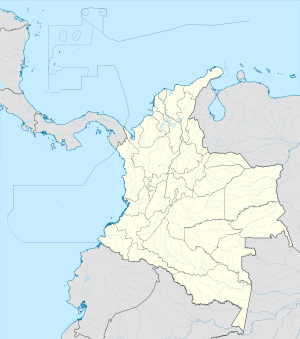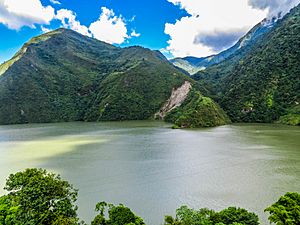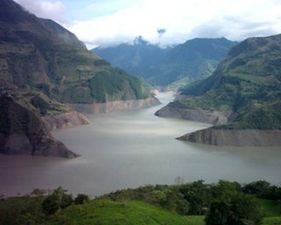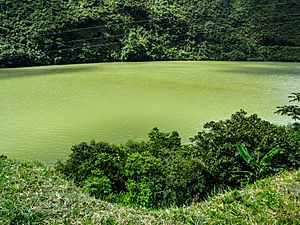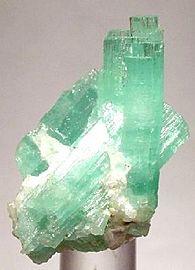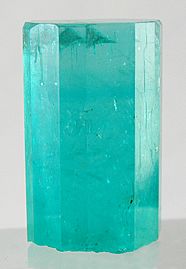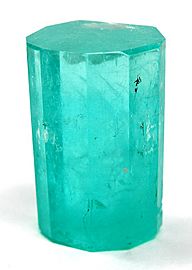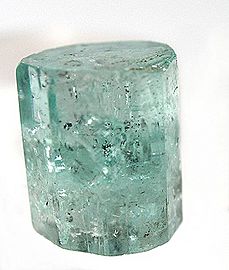Chivor facts for kids
Quick facts for kids
Chivor
|
||
|---|---|---|
|
Town and municipality
|
||
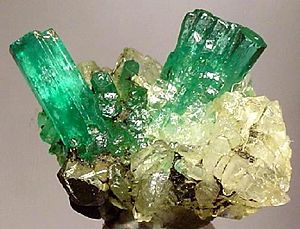
Emeralds mined in Chivor
|
||
|
||
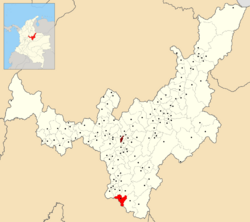
Location of the town and municipality of Chivor in Boyacá Department
|
||
| Country | ||
| Department | Boyacá | |
| Province | Eastern Boyacá Province | |
| Founded | 16 December 1930 | |
| Founded by | Florencio Novoa | |
| Government | ||
| • Type | Municipality | |
| Area | ||
| • Town and municipality | 108.36 km2 (41.84 sq mi) | |
| • Urban | 9.9 km2 (3.8 sq mi) | |
| Elevation | 1,800 m (5,900 ft) | |
| Population
(2015)
|
||
| • Town and municipality | 1,795 | |
| • Density | 16.565/km2 (42.904/sq mi) | |
| • Urban | 486 | |
| Website | Official website: http://www.chivor-boyaca.gov.co/ | |
Chivor is a small town and a municipality in Colombia. It is located in the Boyacá region, specifically in the Eastern Boyacá Province. The town is nestled in the Tenza Valley.
Chivor has a mild average temperature of about 18 °C (64 °F). It is located 215 kilometres (134 mi) away from Tunja, which is the capital city of the Boyacá department. One of the most important activities in Chivor is emerald mining.
Contents
Where is Chivor located?
Chivor shares its borders with several other places. To the north, it borders the municipality of Macanal. To the south, it borders Ubalá in the Cundinamarca region.
On the east side, Chivor borders the municipality of Santa María. To the west, it borders the municipality of Almeida.
What does the name Chivor mean?
The name Chivor comes from the ancient Chibcha language. It has a special meaning. It can mean "Our farmfields - our mother." It can also mean "Green and rich land."
The second meaning, "Green and rich land," refers to the many valuable emeralds found there.
A brief history of Chivor
Long ago, before the Spanish arrived, the Muisca lived in the area where Chivor is today. The Muisca had a group of communities called the Muisca Confederation. They had important leaders, like the zaque in Hunza and the zipa in Bacatá.
Even back then, the Muisca knew about the rich emerald mines in Chivor. They dug for these beautiful green stones. Emeralds were very important to the Muisca. They used them as special offerings in their Muisca religion. They also used them for decoration and even as a form of money.
In 1537, a Spanish conquistador named Gonzalo Jiménez de Quesada found the emerald mines of Chivor. However, the mines were left unused for a long time after that. They were not reopened until 1886.
The modern town of Chivor was officially started much later, on December 16, 1930. It was founded by a person named Florencio Novoa.
What is Chivor's economy like?
The main ways people in Chivor make a living are through agriculture and emerald mining.
Farming in Chivor
Farmers in Chivor grow many different crops. These include maize (corn), yuca, bananas, and sugarcane. They also grow beans, chayote, and coffee. For fruits, they grow papayas, blackberries, and unique Colombian fruits like lulo and tree tomatoes.
Emeralds: Chivor's green treasure
Emerald mining is a very important part of Chivor's economy. In 2014, emeralds worth 30 million US dollars were found in the Boyacá region. Because these emeralds are so valuable, they have sometimes caused disagreements in the area.
Some very famous and large emeralds have been found in Chivor:
- The Gran Esmeralda de Moctezuma (Great Emerald of Moctezuma) is a huge mineral. It is 21 centimetres (8.3 in) tall, 17 centimetres (6.7 in) long, and 16 centimetres (6.3 in) thick. This amazing emerald is now in Vienna, Austria.
- Another famous emerald from Chivor is Patricia. It weighs 632 carats, which is about 126.4 grams (4.46 oz).
- La Magnífica is an even bigger emerald. It weighs 1225 carats, or about 245 grams (8.6 oz).
Emerald Reservoir
The Embalse la Esmeralda is a large reservoir near Chivor. It is also known as the "Emerald reservoir." This reservoir helps produce hydroelectric energy, which is electricity made from water power. The reservoir is managed by the towns of Chivor, Macanal, and Almeida.
What is the climate like in Chivor?
Chivor has a subtropical highland climate. This means it has mild temperatures all year round. It also gets a lot of rain throughout the year.
| Climate data for Chivor | |||||||||||||
|---|---|---|---|---|---|---|---|---|---|---|---|---|---|
| Month | Jan | Feb | Mar | Apr | May | Jun | Jul | Aug | Sep | Oct | Nov | Dec | Year |
| Mean daily maximum °C (°F) | 24.2 (75.6) |
24.6 (76.3) |
24.4 (75.9) |
24.0 (75.2) |
23.2 (73.8) |
21.8 (71.2) |
21.7 (71.1) |
22.1 (71.8) |
22.7 (72.9) |
23.3 (73.9) |
23.5 (74.3) |
23.6 (74.5) |
23.3 (73.9) |
| Daily mean °C (°F) | 18.3 (64.9) |
19.0 (66.2) |
19.4 (66.9) |
19.3 (66.7) |
18.8 (65.8) |
17.8 (64.0) |
17.6 (63.7) |
17.0 (62.6) |
18.0 (64.4) |
18.4 (65.1) |
18.6 (65.5) |
18.3 (64.9) |
18.4 (65.1) |
| Mean daily minimum °C (°F) | 12.5 (54.5) |
13.4 (56.1) |
14.5 (58.1) |
14.6 (58.3) |
14.5 (58.1) |
13.9 (57.0) |
13.6 (56.5) |
13.7 (56.7) |
13.4 (56.1) |
13.6 (56.5) |
13.7 (56.7) |
13.1 (55.6) |
13.7 (56.7) |
| Average rainfall mm (inches) | 41.0 (1.61) |
89.2 (3.51) |
137.5 (5.41) |
262.3 (10.33) |
373.5 (14.70) |
401.3 (15.80) |
405.1 (15.95) |
333.8 (13.14) |
242.9 (9.56) |
197.4 (7.77) |
143.2 (5.64) |
67.9 (2.67) |
2,695.1 (106.09) |
| Average rainy days | 9 | 12 | 17 | 24 | 27 | 28 | 28 | 27 | 23 | 23 | 20 | 13 | 251 |
| Source 1: IDEAM | |||||||||||||
| Source 2: Climate-Data.org | |||||||||||||
Images for kids
See also
 In Spanish: Chivor para niños
In Spanish: Chivor para niños



